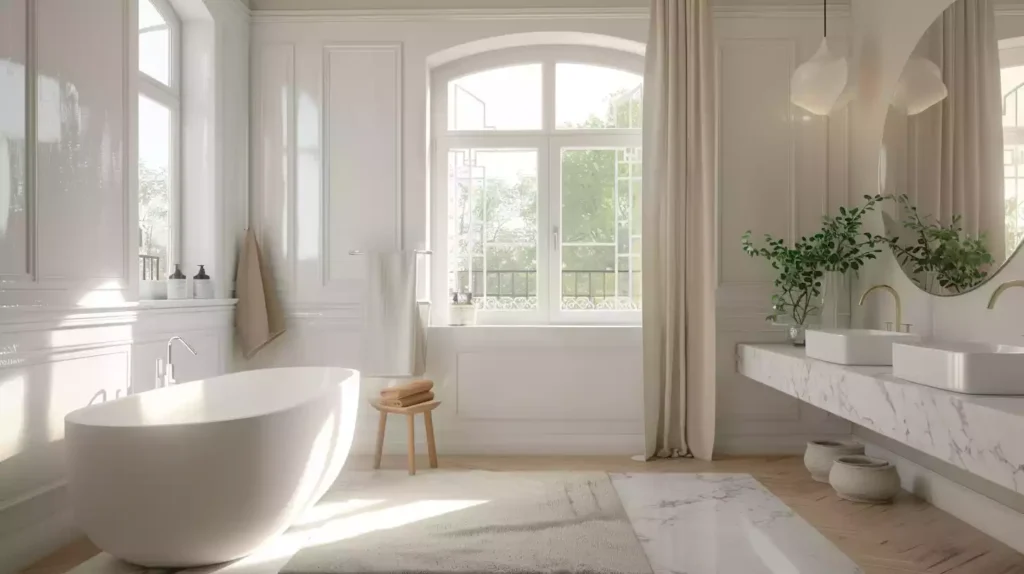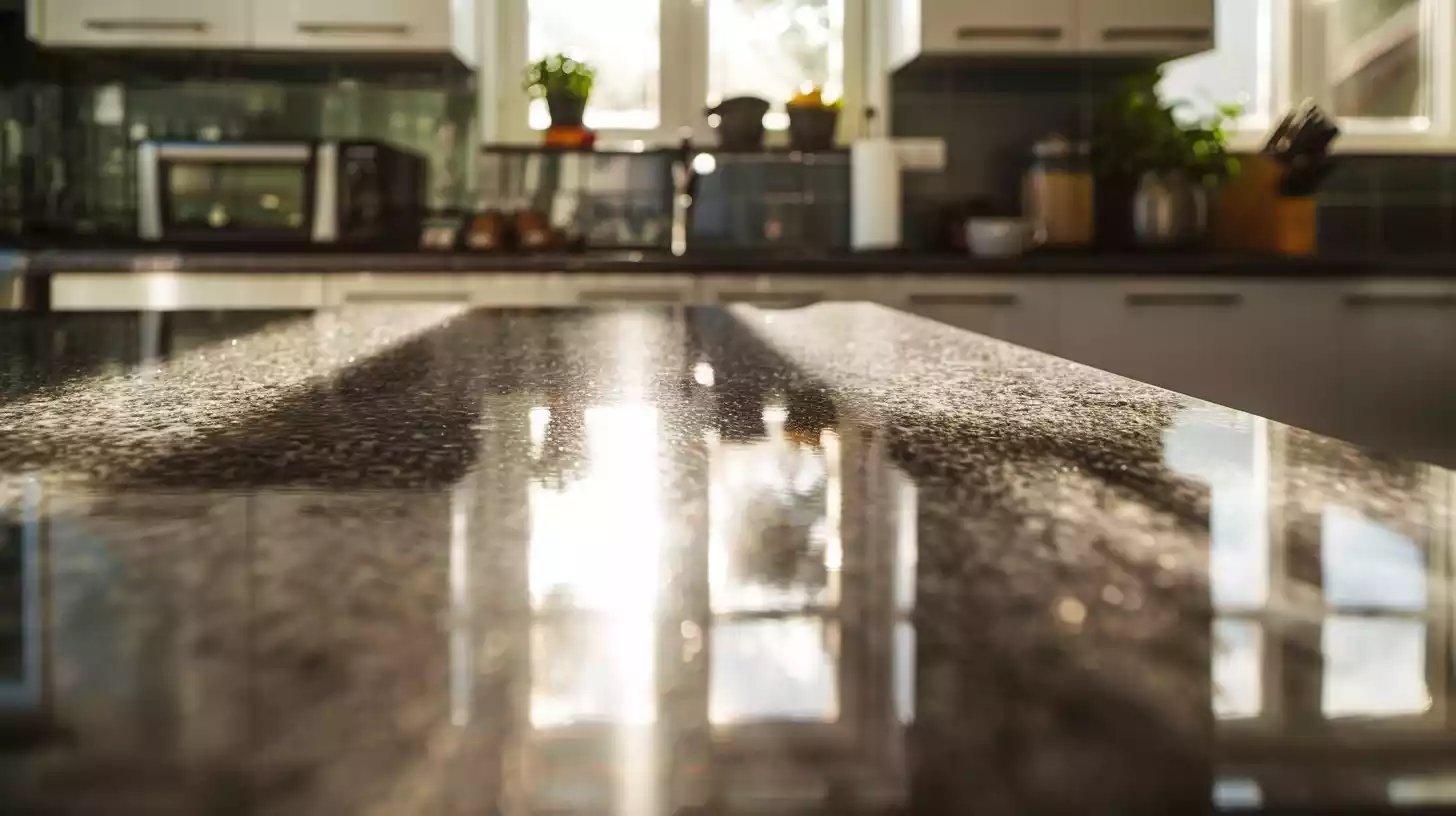The standard is 25.5 inches, which gives you ample workspace while keeping things visually balanced. But the depth can vary based on factors like kitchen size, your personal preferences, and the kind of cooking and baking you do.
Deeper counters work well in larger kitchens, while shallower ones create an airier feel in smaller spaces. And of course, the size of your appliances plays a big role too.
Curious to learn more about customizing the depth for your dream kitchen?
Quick Summary
- The standard depth of kitchen countertops is 25.5 inches, including a 24-inch cabinet depth and a 1.5-inch overhang.
- The minimum depth for kitchen islands is typically 27-30 inches to provide ample workspace and seating comfort.
- The recommended depth for cooking surfaces is 24-25 inches, while for baking and food prep areas, a depth of 28-30 inches works best.
- Countertop depth can be customized to achieve specific design goals, ranging from 22-24 inches for a more open feel to 27-28 inches for increased workspace.
- Appliance size plays a key role in determining the appropriate countertop depth, which may vary from the standard 24-25 inches.
Standard Kitchen Countertop Depth
The standard depth of kitchen countertops is 25.5 inches, which includes a 24-inch cabinet depth and a 1.5-inch overhang. This standard dimension is the most common choice for kitchen design, providing ample workspace while maintaining a visually appealing proportionality.
The depth of the countertop plays a vital role in the overall kitchen design. Deeper countertops, typically 27-28 inches, are often preferred in larger kitchens, as they offer more workspace and can accommodate larger appliances or under-counter storage.
Conversely, shallower countertops, between 22-24 inches, may be favored in smaller kitchens to maximize space and create a more open floor plan.
Factors Determining Countertop Depth
Various factors influence the depth selection of kitchen countertops, such as the size of the kitchen, personal preference, and the intended use of the workspace.
For instance, I might choose a deeper countertop if I need more prep space, while a shallower one could work better in a smaller kitchen. Countertop dimensions can also impact the overall kitchen interior design.
| Factors | Considerations | Impacts |
|---|---|---|
| Kitchen Size | Larger kitchens can accommodate deeper countertops | Enhances workspace and storage |
| Usage | Heavy-duty cooking and baking require more depth | Provides ample room for appliances and prep |
| Aesthetics | Countertop depth affects visual balance and flow | Contributes to the kitchen’s cohesive look |
I always consider the size of my kitchen, how I plan to use the countertops, and my personal style preferences to determine the ideal depth. A careful assessment of these factors guarantees I choose a countertop that’s both functional and visually appealing.
Minimum Depth for Kitchen Islands
When designing a kitchen island, the minimum depth is also important to consider.
I typically recommend a depth of around 27-30 inches to provide ample workspace and seating comfort.
Of course, the ideal dimensions also depend on the specific needs and layout of the kitchen, but this range tends to work well in most cases.
Optimal Island Dimensions
Determining the ideal island depth is essential for ensuring a kitchen’s functionality and layout.
Typically, a minimum depth of 27-28 inches provides adequate space for necessary appliances and movement around the island, making it a common recommendation for many kitchens.
Larger islands with a depth of 30 inches or more can accommodate more substantial appliances, additional seating, and increased counter space – perfect for big families or avid home chefs.
However, in smaller kitchens, a depth of 24 inches may be more practical, though it’ll require some smart planning to maximize the island’s usefulness.
The ideal island depth depends on the specific appliances and features you want to incorporate, as well as the overall size and layout of your kitchen.
It’s all about finding the right balance between island depth, functionality, and available space.
With a little compromise, you can create an island that’s both stylish and supremely functional, and in the end, you’ll have an island that meets your needs and complements your kitchen’s unique characteristics.
Countertop Overhang Requirements
Beyond the ideal island dimensions discussed previously, the required overhang for kitchen island countertops is an important consideration that affects the overall depth.
While the minimum depth is typically around 27-28 inches, a depth of 30 inches or more is recommended for islands with seating to provide comfortable legroom and knee clearance. Furthermore, the depth should account for the size and type of appliances, as a deeper island provides more countertop space and storage.
However, this needs to be balanced against making the kitchen feel cramped, especially in smaller spaces.
The ADA recommends a minimum knee clearance of 27 inches, but this can be adjusted based on individual needs and preferences.
| Countertop Overhang | Minimum Depth | Legroom/Knee Clearance |
|---|---|---|
| 27-28 inches | Typical | Minimal |
| 30 inches or more | Recommended | Comfortable |
| ADA Recommendations | Adjustable | 27 inches minimum |
Bathroom Countertop Depth Considerations

When it comes to bathroom countertops, the depth is a vital consideration.
The ideal depth depends on the available space, design goals, and the needs of the people using the bathroom.
It’s all about finding the right balance between functionality and aesthetics to create a comfortable and accessible space.
Space Planning Requirements
Considering the Americans with Disabilities Act‘s recommended minimums, I typically aim for at least 30 inches of accessible space and 27 inches of knee clearance underneath the bathroom countertop. This allows for the countertop to be accessible for users of all abilities, including those in wheelchairs.
When it comes to the depth of the countertop, I factor in the depth of the base cabinet, the size of the room, and the overall style of the bathroom. For example, I’d choose a slightly shallower 19 1/2-inch depth for a powder room, while a primary en-suite bathroom might warrant a deeper 22 1/2-inch countertop.
The key is striking the right balance between functionality, aesthetics, and accessibility. I also consider the countertop materials – LX Hausys’ engineered quartz surfaces are a great option as they’re durable, easy to clean, and available in a range of depths to suit any bathroom remodeling project.
At the end of the day, proper space planning is vital for creating a bathroom that’s both beautiful and usable.
Clearance for Plumbing
I must consider the necessary clearance for plumbing when determining the ideal depth of a bathroom countertop. During kitchen remodeling, I’ve learned that the depth of the kitchen countertop is crucial, not just for aesthetics, but also for practical concerns like plumbing installation.
The same principle applies to bathroom countertops – I need to ensure there’s sufficient clearance for the plumbing fixtures and pipes underneath.
Typically, a minimum depth of 21 inches is recommended for bathroom countertops to accommodate the plumbing. However, the exact clearance required can vary depending on the countertop material, cabinet depth, and the specific plumbing configuration.
I’ll also need to consider the counter edge profile, as a thicker countertop may need more clearance. By carefully planning the countertop dimensions and working closely with my plumber, I can create a functional and visually appealing bathroom design that seamlessly integrates the plumbing.
Striking the right balance between countertop depth and plumbing clearance is key to a successful bathroom remodel.
Ergonomics and Countertop Depth
The standard countertop depth of 25-25.5 inches is based on the average elbow height of an adult, which aims to reduce strain on the arms and shoulders during food preparation.
Ergonomics play a vital role in kitchen design, and getting the countertop depth right is essential for comfort and safety. A depth that’s too deep can cause users to hunch over, leading to back and shoulder issues, while a depth that’s too shallow forces users to reach forward, straining their wrists and arms.
The recommended depth for cooking surfaces is 24-25 inches, allowing for comfortable standing and movement. For baking and food prep areas, a depth of 28-30 inches works best.
The ADA also has guidelines, suggesting a minimum of 30 inches of accessible space and 27 inches of knee clearance to accommodate wheelchair users.
Whether you’re renovating or starting from scratch, keeping ergonomics in mind is key to creating a kitchen that’s both functional and user-friendly.
Appliance Size and Countertop Depth
Along with ergonomics, the size of appliances also plays a key role in determining the appropriate countertop depth.
I’ll need to account for the depth of my oven, refrigerator, and other major kitchen equipment when deciding on the ideal countertop dimensions.
Standard counter depth is typically 24-25 inches, but this can vary depending on the size of my kitchen appliances.
For instance, if I’ve a deeper oven or fridge, I may need to increase the kitchen countertop depth to 26-27 inches to guarantee everything fits comfortably.
The depth of my kitchen island is another important factor – it should be deep enough to accommodate any overhanging appliances while still providing ample workspace.
The counter depth requirements will depend on the specific layout and appliances in my kitchen.
How Can the Depth of Kitchen Countertops and Cabinets Affect the Balance in a Kitchen Design?
When considering kitchen countertop options, the depth of countertops and cabinets plays a crucial role in achieving balance in kitchen design. Deeper countertops can provide more workspace and storage, but they can also create a bulky, unbalanced look. It’s important to consider the overall layout and functionality when choosing the depth of kitchen surfaces.
Customizing Countertop Depth for Design
Customizing the countertop depth can help achieve specific design goals in the kitchen. Standard 25-inch depths can be adjusted to create a more open floor plan or maximize workspace, depending on the size and layout of the room.
For larger kitchens, deeper countertops between 27-28 inches can provide ample space for food preparation and under-counter storage.
In compact spaces, shallower 22-24 inch countertops can create a sense of openness and airiness, perfect for smaller kitchens.
Island countertops can be designed with varying depths to serve different functions – a 30-inch deep section for seating, and a 25-inch deep section for food prep.
Ergonomic factors are also considered, aiming to position the countertop 3-4 inches below the elbow to minimize arm and shoulder strain during cooking.
Workspace optimization is key, so the depth can be customized as needed to facilitate the kitchen having the right balance of open floor plan and functional prep areas.

